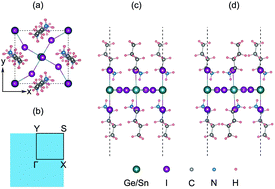Investigation of strain behavior and carrier mobility of organic–inorganic hybrid perovskites: (C4H9NH3)2GeI4 and (C4H9NH3)2SnI4†
Abstract
Two dimensional (2D) organic–inorganic hybrid perovskites have attracted great interest due to their tunable band gap and structural stability. In this study, biaxial strain behavior and carrier mobility of monolayers (C4H9NH3)2GeI4 and (C4H9NH3)2SnI4 are investigated by first principles calculations. (C4H9NH3)2GeI4 and (C4H9NH3)2SnI4 still retain their structural stability at ε = 13% and ε = 15%, respectively. Ab initio molecular dynamics (AIMD) simulation has confirmed that the system at 300 K is still thermodynamically stable at a biaxial strain of ε = 8%. The band gaps of (C4H9NH3)2GeI4 and (C4H9NH3)2SnI4 calculated from the HSE06 functional are increased from 2.427 and 1.953 eV at zero strain to 3.002 and 2.626 eV at ε = 8%. Deformation potential (DP) models based on longitudinal acoustic phonon (LAP) and optical phonon (OP) scattering are used to investigate mobility. The mobility of (C4H9NH3)2GeI4 is lower than that of (C4H9NH3)2SnI4. It is mainly determined by the scattering from OP with lower energy and decreases sharply with an increase in biaxial strain. Compared with Pb based perovskites, (C4H9NH3)2SnI4 exhibits high carrier mobility and thermodynamic stability.

- This article is part of the themed collection: 2020 Nanoscale HOT Article Collection


 Please wait while we load your content...
Please wait while we load your content...